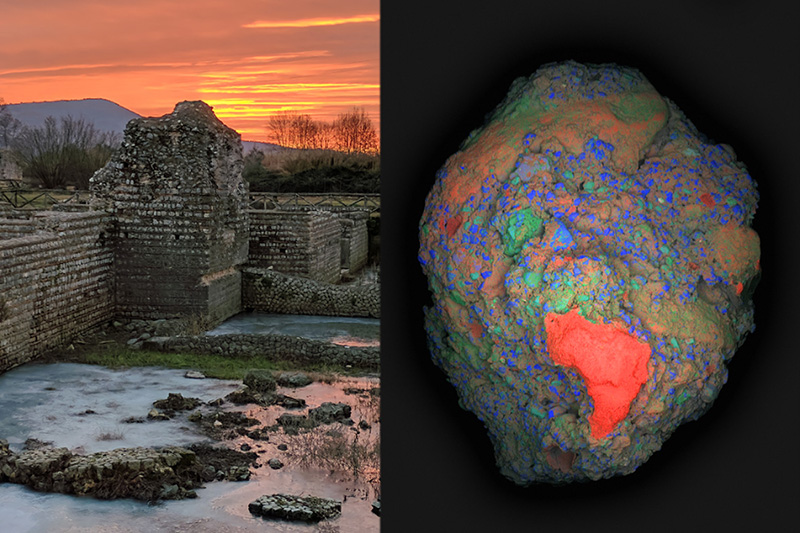Ancient Roman concrete found to have self-healing capability
Ancient Roman concrete structures have survived for two millennia; self-healing has been cited as the reason for this super-durability.

A large-area elemental map (calcium: red, silicon: blue, aluminum: green) of a 2cm fragment of ancient Roman concrete (right) collected from the archaeological site of Privernum, Italy (left). A calcium-rich lime clast (in red), which is responsible for the unique self-healing properties in this ancient material, is clearly visible in the lower region of the image
© Courtesy of the researchers, Massachusetts Institute of TechnologyThe Pantheon in Rome, dedicated in A.D.128, has the world's largest unreinforced concrete dome, and is still intact, while some ancient Roman aqueducts still carry water. Many modern concrete structures have crumbled only after a few decades.
Ancient concrete-manufacturing strategies that incorporated several key self-healing functionalities have been uncovered by investigators from the Massachusetts Institute of Technology and Harvard University, both in the USA, along with laboratories in Italy and Switzerland.
For a long time researchers assumed that the pozzolanic material, such as volcanic ash from Pozzuoli on the Bay of Napels, was fundamental to the ancient concrete's durability. This was shipped across the Roman empire for construction and described as a key ingredient for concrete by architects at the time.
Close examination shows these ancient samples contain small, distinctive, millimetre-scale, bright white mineral features, long recognised as characteristic of Roman concretes. Often called 'lime clasts', they were previously thought of as resulting from sloppy mixing practices.
These tiny lime clasts have been found to have previously unrecognised self-healing capabilities. It was assumed that lime was incorporated after it had been combined with water as a reactive paste, known as slaking.
High-resolution multiscale imaging and chemical mapping techniques reveal that the white inclusions were made out of various forms of calcium carbonate and showed that the Romans had added quicklime - a more reactive form of lime.
Spectroscopic examination pointed to these lime clasts forming at extreme temperatures, as expected by quicklime. Hot mixing has been revealed as essential for the ancient Roman's super-durable concrete.
During hot mixing the lime clasts develop characteristically brittle nanoparticulate architecture, creating an easily fractured and reactive calcium source. As soon as cracks form within the concrete, they can preferentially travel through the high-surface-area lime clasts. This then reacts with water, creating a calcium-saturated solution, which can recrystallise as calcium carbonate and quickly fill the crack, or react with pozzolanic materials to further strengthen the composite. These reactions have been found to be spontaneous and automatically heal the cracks before they spread.
To prove this, the team produced samples of hot-mixed concrete using ancient and modern formulations, cracked them and then ran water through the cracks. Within two weeks, the cracks had completely healed and water could not flow. Identical concrete without quicklime never healed.
The team is now working to commercialise this modified cement. 'It’s exciting to think about how these more durable concrete formulations could expand not only the service life of these materials, but also how it could improve the durability of 3D-printed concrete formulations,' says MIT Professor of Civil and Environmental Engineering Admir Masic.







